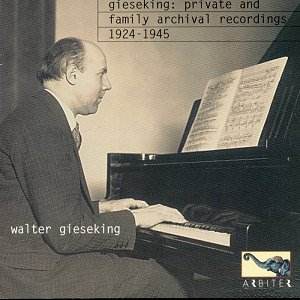Derived
from broadcast performances and unissued test pressings this uneven
but rather fascinating collection is augmented by Arbiter’s characteristically
splendid photographs and chronological material. It rounds out
a portrait of the younger Gieseking since there’s also a splendidly
witty – if down in the dumps – letter from the pianist written
to his wife whilst he was stuck in some "hick town"
during his 1926 American tour. The preserved material ranges from
a 1924 British Homochord test pressing – its companion was recorded
the following year – to the Berlin radio broadcasts in 1945 of
Schubert and Schumann’s Etudes Symphoniques. Much here refutes
the – in some quarters – received view of Gieseking as a miniaturist
and purveyor of exquisite refinement. Those who have heard his
blistering Rachmaninov Concertos recorded live or the torso of
the Brahms’ Second Concerto, a wartime survival also on Arbiter,
will know exactly what else was in Gieseking’s armoury however
imperfect the technique could sometimes become.
There
is indeed evidence of some technical stress but much else besides
that is of incomparably more importance. His Schubert can be forthright;
the Rondo from D850 is not at all prettified and his dynamic variance
in the little Sonata in A is impressive and cogent. The finale
in particular responds well to his strong attacks and his control
of syntax. The preservation of the January 1945 Berlin broadcast
was however particularly notable for the Schumann Etudes Symphoniques
and I suspect, though this isn’t noted in the documentation, that
Gieseking had incorporated the revisions of the second edition.
There are some rather peremptory accents here and there but great
nobility of utterance as well – in the slow but grave Thema, the
control of the Second Variation, the consummate involvement of
the Fifth and the driving, risk-taking finale.
The
Homochords have the usual ration of surface noise but they’re
quite listenable. Arbiter has also retained the level of shellac
noise between these two sides, a practice I wish more companies
would follow. The ear adjusts quickly to a consistent level of
noise and doesn’t have to keep cranking itself up and down to
accommodate the violent silence. And the performances are characterful
and quite vibrant: good Scarlatti playing for the date. His Bach
is perhaps less recommendable and the sole example here from the
Second Book of the Well Tempered Clavier, a 1925 Homochord test
pressing, is relatively lightweight and superficial. In Mozart,
however, things are greatly in his favour. The Sonata in D is
a test pressing from about 1940-42 and was a work he was successfully
to record in an EMI session in 1953. This earlier attempt shares
many of the most attractive features that distinguish the commercial
disc – generosity of spirit, beautiful touch, easy flowing elegance
and a concomitant depth of expressivity in the Adagio. Kinderszenen
is here provisionally dated to c1940 but the sound is very distant
and surface noise relatively high. Gieseking is sometimes a little
prosaic in his phrasing (Curiose geschichte) but elsewhere
appositely affectionate.
Much
of the material has survived in relatively good conditions, small
instances of distortion on the 1945 tapes and acetate damage aside.
The documentation as I said has some excellent pictures, of Gieseking
rehearsing with Huberman and a sepia tinted collectors item from
the 1920s of the impish Hindemith smiling at a scarily intense
Klemperer, Gieseking happily bisecting them with a straight to
camera grin.
Jonathan
Woolf
